58 Low Growing Shrubs for the Front of the House (With Pictures): Identification Guide
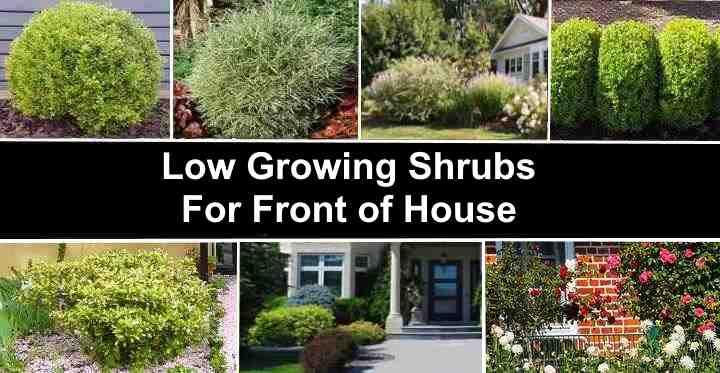
Low-growing shrubs for front-of-house planting are a great way to add curb appeal and enhance your home’s appearance. Compact and bushy shrubs are perfect for planting in front of windows, along walkways and driveways, or as borders. They provide a neat and tidy look while adding color and texture to your front yard landscape.
Low-growing shrubs for a front yard can be deciduous, evergreen, or coniferous plants. Many dwarf, compact shrubs have beautiful flowers to brighten up the front of your house. Other evergreen broadleaf shrubs keep your front yard lush and vibrant throughout the year.
Choosing the right low-growing shrubs for the front of your house can be overwhelming. To help landscape your front garden, this article has descriptions and pictures of the best shrubs that don’t grow too tall. Additionally, you will find tips on how to care for these shrubs for optimal growth and maintenance.
What are Low-Growing Shrubs for the Front of House?
Dwarf shrubs are small, woody plants ideal for planting at the front of the house. Front yard shrubs typically grow 1 to 3 ft. (0.3 – 1 m) tall and wide. This compact size makes them perfect for lining walkways, planting along a foundation, and increasing the overall visual attractiveness without taking up too much space.
Some of the most popular low-growing shrubs for front-of-house planting are boxwoods, barberry shrubs, dwarf holly bushes, and low-growing azaleas. These attractive, compact, bushy plants help enhance your home’s exterior, boosting curb appeal. Many dwarf shrubs are suitable for growing in the shade—ideal if your front door faces north.
Low Growing Shrubs for the Front of House (With Pictures): Identification Guide
Let’s take a detailed look at the best low-growing shrubs for front-of-house landscaping.
Dwarf Japanese Pieris Shrub (Pieris japonica ‘Cavatine’)
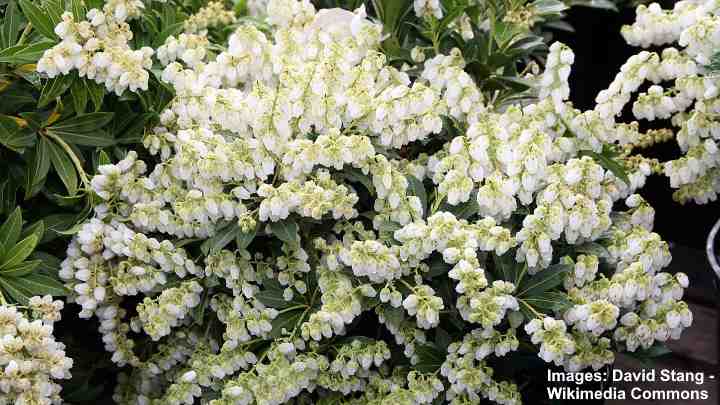
The dwarf Japanese Pieris cultivar ‘Cavatine’ is a compact evergreen flowering shrub to beautify a front yard’s landscape for instant curb appeal. The striking shrub has clusters of small, bell-shaped white flowers dangling on arching stems. The lance-shaped leaves emerge bronze in spring, mature to dark green in summer, and turn reddish-bronze in fall.
Thriving in full sun to partial shade, the dwarf Japanese Pieris shrub is a versatile addition to any front garden. It doesn’t grow taller than 2.5 ft. (0.76 m), making the shrub ideal for foundation planting, lining a driveway, or growing in a container beside the front door. This compact shrub with its fragrant bell-shaped white flowers looks lovely at the front of the house, attracting bees, and other pollinators when blooming in early spring
- USDA Zone: 5 to 9
- Sun Exposure: Full sun to partial shade
- Soil Type: Rich, acidic soil with excellent drainage
Dwarf Gardenia (Gardenia jasminoides ‘Radicans’)

Dwarf gardenia ‘Radicans’ is a compact, low-growing evergreen shrub with a spreading habit that enhances curb appeal. This gardenia cultivar is a popular low-growing shrub for front of house landscaping due to its beautiful, fragrant white flowers and glossy green foliage. The dwarf gardenia doesn’t grow taller than 1 ft. (0.3 m).
The compact shrub has many uses—it’s ideal for planting under windows, lining pathways, or creating a lush mat of greenery. Its spreading, ground-hugging habit makes it ideal for ground cover, decorating beds and borders, or growing in containers. Blooming late spring to early summer, the small shrub fills outdoor spaces with sweet and intoxicating fragrances.
- USDA Zone: 8 to 11
- Sun Exposure: Partial shade to full sun
- Soil Type: Well-drained, acidic soil
Low-Growing Juniper Shrubs (Juniperus)
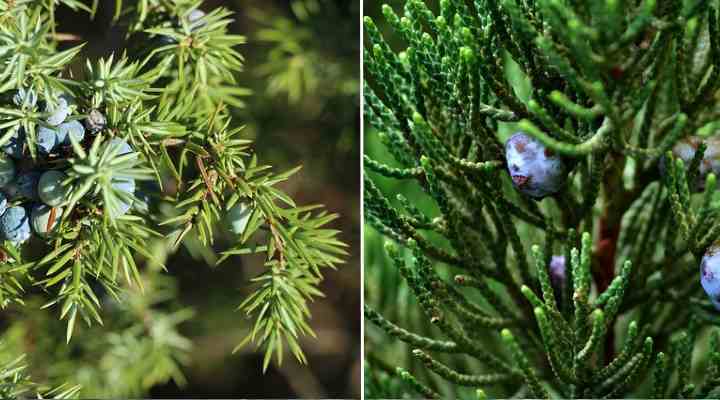
Low-growing juniper shrubs are versatile and hardy coniferous plants that add texture and evergreen color to front of house landscaping. Dwarf junipers are known for their low, spreading growth habit and attractive foliage. Junipers provide different foliage options depending on your landscaping requirements. These include green, blue, silver, and gold shades.
Small, compact juniper shrubs are drought-tolerant and can withstand various soil conditions. These facts make them low-maintenance and easy to grow. Here are a few low-growing juniper shrubs to bring an element of subtle elegance to a front façade.
Creeping Juniper (Juniperus horizontalis): The creeping juniper is a sprawling evergreen shrub forming a soft mat of blue-green needle-like leaves. The sun-loving shrub grows around 1 ft. (0.3 m) tall and 8 ft. (2.4 m) wide. It’s drought and heat-tolerant, suitable for USDA zones 3 to 9.
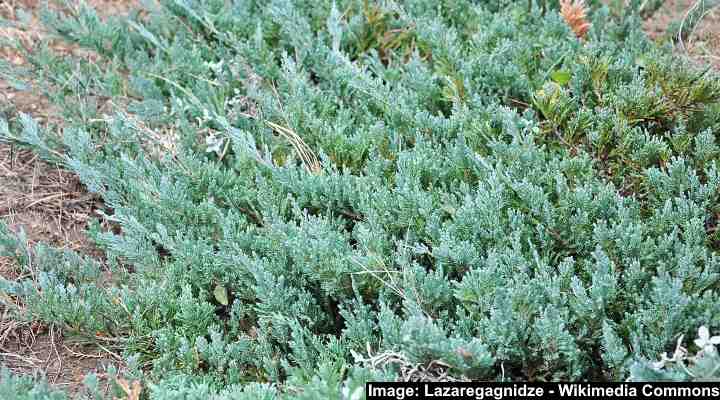
Creeping Juniper (Juniperus horizontalis)
Blue Star Juniper (Juniperus squamata ‘Blue Star’): This evergreen shrub stays close to the ground, bringing vitality and vibrancy to your home’s forefront. The conifer shrub has a mounding habit with silver-blue foliage. It’s ideal as a foundation planting, bushy ground cover, or a specimen shrub. Suitable for USDA zones 4 to 8 and grows 2 to 3 ft. (0.6 – 1 m) tall and 4 ft. (1.2 m) wide.

Blue Star Juniper (Juniperus squamata ‘Blue Star’)
Blue Rug Juniper (Juniperus horizontalis ‘Wiltonii’): This low-growing, mat-forming evergreen shrub has dense, silver-green foliage growing on long, horizontally spreading branches. It’s one of the best ground cover junipers for front yards in USDA zones 3 to 9. The juniper shrub grows less than 1 ft. (0.3 m) tall with a spread up to 8 ft. (2.4 m).
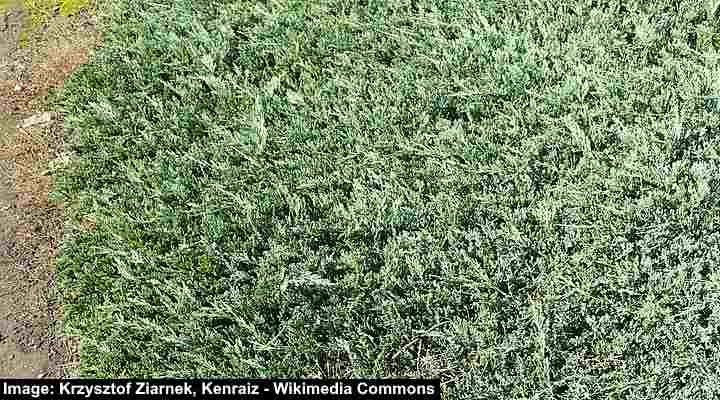
Blue Rug Juniper (Juniperus horizontalis ‘Wiltonii’)
Dwarf Colorado Spruce (Picea pungens ‘Globosa’)
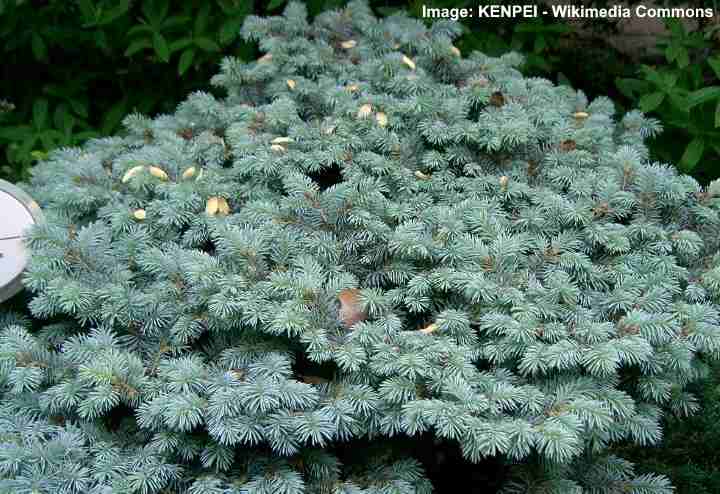
The dwarf Colorado spruce is a small evergreen shrub with a compact, pyramidal shape. Ideal small shrub for front-of-house planting, this slow-growing conifer is identified by its blue-green rigid needles, low height, and horizontal branches. The small landscaping conifer grows 3 to 5 feet (0.9 – 1.5 m) with a spread up to 6 ft. (1.2 – 1.8 m).
The dwarf Colorado spruce is an award-winning low-maintenance shrub. It tolerates a wide range of soil conditions and is easy to grow and care for. It’s drought-tolerant and great for small front gardens, border fronts, and rock gardens.
- USDA Zone: 2 to 8
- Sun Exposure: Full sun
- Soil Type: Acidic, well-drained, moist soil
Dwarf Bottlebrush (Callistemon viminalis ‘Little John’)
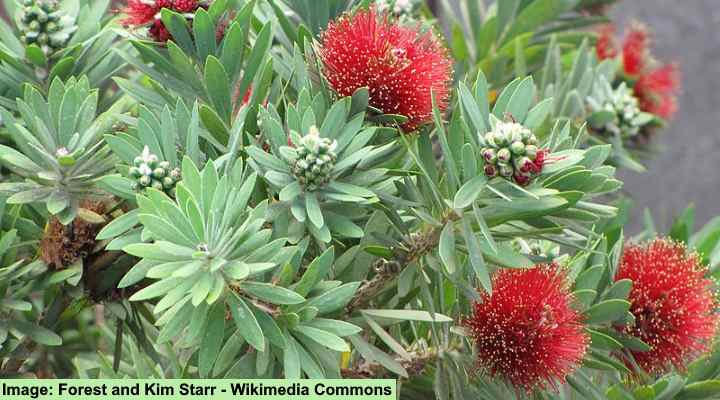
The dwarf bottlebrush cultivar ‘Little John’ can enhance your home’s curb appeal despite its small size. This compact shrub is particularly charming at the front of the house due to its flowers, which have bristle-like stamens in cylindrical clusters resembling brushes used to clean bottles. The brush-like flowers bloom in spring and summer in vibrant red shades. This bottlebrush cultivar doesn’t grow taller than 3 ft. (1 m).
Dwarf bottlebrush is a slow-growing red-flowering evergreen shrub that attracts birds and hummingbirds to front yards. The compact size of the ‘Little John’ cultivar makes it ideal for small front gardens, borders, and containers. Thriving in full sun to light shade, this compact shrub can also be used as a hedge or as a focal point in the landscape. It’s also salt-tolerant, making it a good choice for coastal landscapes.
- USDA Zone: 8 to 12
- Sun Exposure: Full sun or light shade
- Soil Type: Well-drained, acidic soil
Dwarf Encore Azalea Flowering Shrubs (Rhododendron spp.)
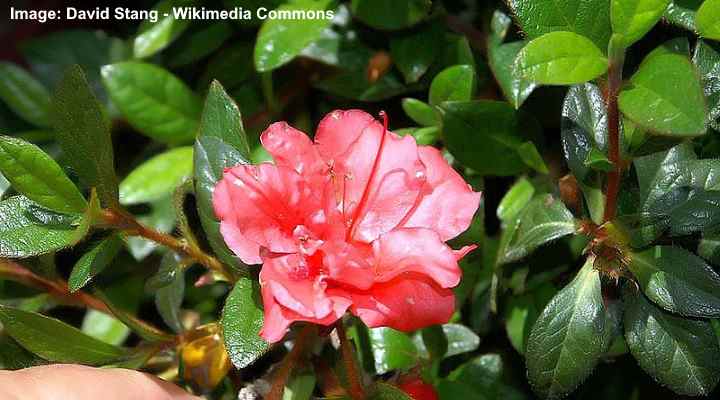
Azaleas from the Encore range are compact, evergreen shrubs growing less than 3 ft. (1 m) tall. These small, bushy plants have a long blooming time—first in spring before reblooming sporadically from summer to frost. Compact, dwarf azalea shrubs add a pop of color to the front of the house landscape throughout the growing season.
Encore azaleas are known for their trumpet-shaped flowers in various pink, red, purple, and white shades. These clusters of small, showy flowers contrast beautifully with the shrub’s glossy, dark green foliage.
Landscaping uses for these repeat blooming azalea shrubs include shrub borders, flowering hedges, foundation planting, and front lawn plants. They also make excellent container plants to place on either side of a front entranceway.
- USDA Zone: 6 to 10
- Sun Exposure: Partial shade to full sun
- Soil Type: Humus-rich, well-drained, acidic soil
Dwarf Azalea (Rhododendron spp.)
Dwarf azaleas are popular shrubs for front yard landscaping due to their vibrant and showy flowers. The compact shrubs have clusters of trumpet-shaped papery flowers. The single or double blooms can have frilly, ruffled, or twisted petals that bloom in spring. Some dwarf azaleas don’t grow taller than 2 feet (0.6 m) tall.
Here are three low-growing azalea shrubs suitable for front yard landscaping:
Rhododendron ‘Princess Anne’: Growing 2 to 3 ft. (0.6 – 0.9 m) tall, the small front-of-house shrub has pale yellow, funnel-shaped flowers.
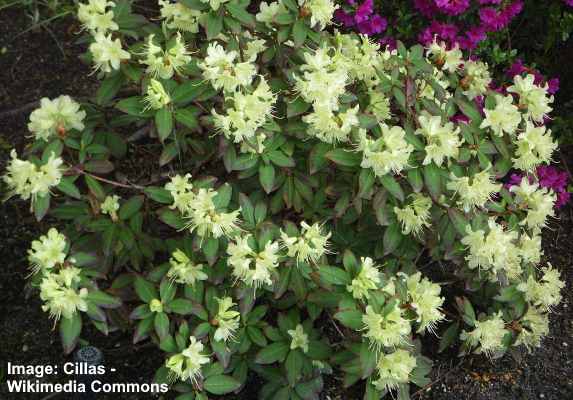
Rhododendron ‘Princess Anne’
Rhododendron ‘Ramapo’: This front-yard shrub grows 2 feet (0.6 m) tall, making it suitable for compact landscapes. The stunning dwarf azalea has clusters of beautiful purple flowers.
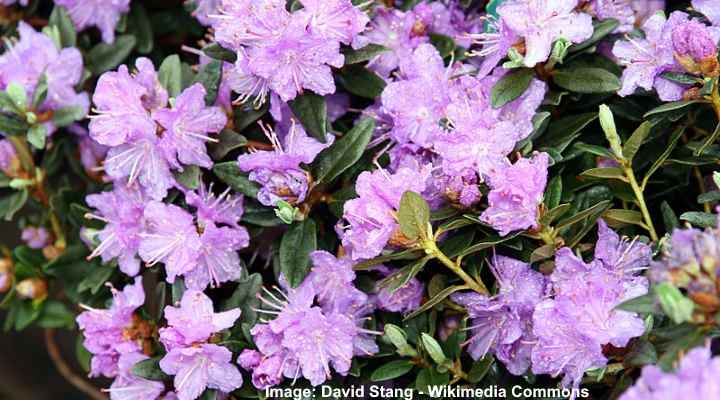
Rhododendron ‘Ramapo’
Rhododendron ‘Percy-Wiseman’: This small azalea shrub has clusters of pretty pinkish-white flowers, with up to 5 showy flowers per cluster. The shrub grows 4 to 6 ft. (.12 – 1.8 m) tall.
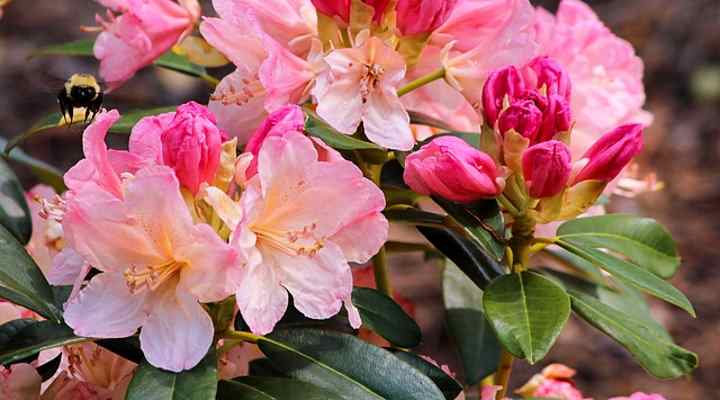
Rhododendron ‘Percy-Wiseman’
- USDA Zone: 4 to 9, depending on the specific cultivar
- Sun Exposure: Full sun to partial shade
- Soil Type: Well-drained, acidic, humus-rich soil
Shrubby Cinquefoil (Potentilla fruticosa)

Shrubby cinquefoil is a beautiful low-growing yellow-flowering shrub to elevate your front yard’s style and elegance. The hardy shrub blooms in spring and throughout summer with beautiful, long-lasting yellow flowers. Shrubby cinquefoil looks lovely in front of a house due to its yellow blossoms that contrast nicely with the mound of bluish-green leaves. Shrubby cinquefoil grows 2 to 4 ft. (0.6 – 1.2 m) tall.
Shrubby cinquefoil is a versatile plant with many uses in front yard settings. The compact, bushy shrub looks attractive in mixed flower beds, shrub borders along a driveway, or as a low-growing hedge. It’s also cold-hardy and won’t wilt in hot summer temperatures, making it one of the easiest front-yard shrubs to grow.
- USDA Zone: 3 to 7
- Sun Exposure: Full sun to partial shade
- Soil Type: Most soil types, including dry, salt, and poor soils
Dwarf Spirea Shrubs
Low-growing spirea shrubs can form a beautiful fringe along your home’s façade, enhancing its visual appeal. Miniature spireas have a round, mounding habit and produce abundant pink and white flowers from spring to early summer. The flowering branches grow in all directions, giving the shrubs an eye-catching appearance.
Here are some examples of compact, low-growing spirea shrubs for planting in a front garden.
Spirea nipponica ‘Snowmound’: Growing 4 ft. (1.2 m) tall, this deciduous shrub has a rounded, compact form. It blooms in late spring with clusters of brilliant white flowers covering the branches until early summer.
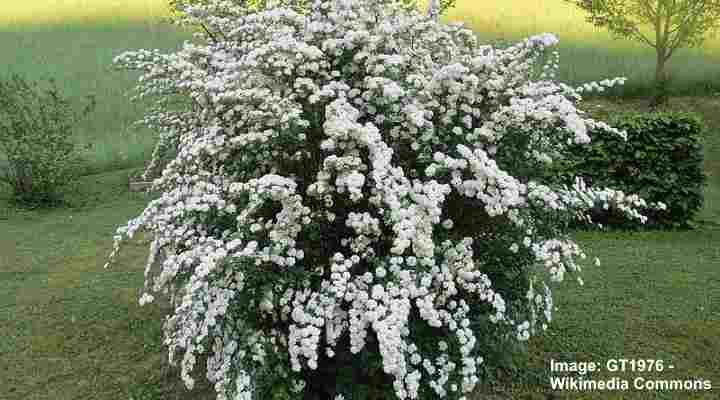
Spirea nipponica ‘Snowmound’
Little Bonnie Dwarf Spiraea (Spiraea x bumalda ‘Little Bonnie’): This compact shrub has small, lance-shaped green leaves and clusters of pink flowers that bloom in the spring and summer. It grows 2 to 3 ft. (0.6 – 1 m) tall and wide.

Little Bonnie Dwarf Spiraea (Spiraea x bumalda ‘Little Bonnie’)
Spiraea japonica ‘Gold Mound’: The front-of-the-house compact shrub has golden-yellow foliage that turns a vibrant orange-red in the fall. In early spring, pink flowers appear and last until summer. It grows to 2 – 3 ft. (60 – 90 cm) tall and 3 – 4 ft. (0.9 – 1.2 m) wide.
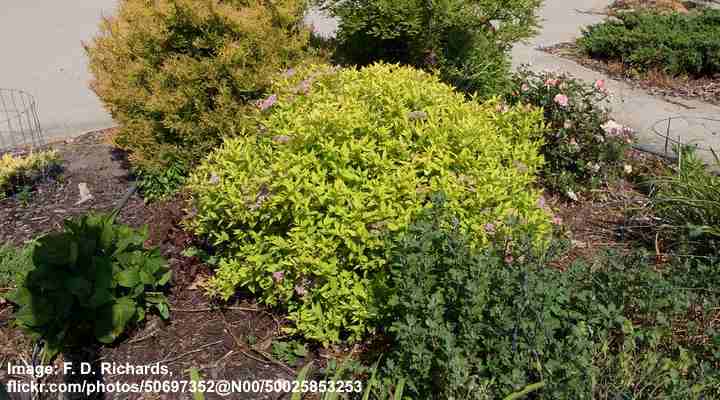
Winter Heath (Erica carnea)
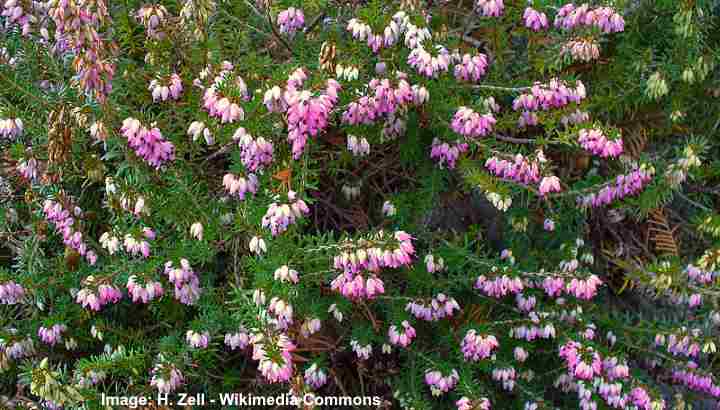
Winter heath is a low-growing evergreen flowering shrub with vertical flowering spikes to add height and beauty to a front yard. This hardy decorative shrub is identified by its small, bell-shaped flowers in various shades of white, pink, red, purple, and yellow. The attractive mounding plants grow 1 to 2 ft. (0.3 – 0.6 m) tall.
Winter heath spreads out to form a dense, ground-covering mat. It is easy to grow in rock gardens, containers, and along pathways. The low-growing shrub blooms early in the season and provides four-season interest for front yard landscaping.
- USDA Zone: 5 to 8
- Sun Exposure: Full sun to partial shade
- Soil Type: Well-drained, acidic soil
Bluebeard (Caryopteris x clandonensis)

Bluebeard is a small deciduous shrub to add a splash of vibrant purple-blue colors to the front of the house. The blue-flowering shrub is known for its aromatic deep bluish-purple flowers that bloom in late summer to early fall. These blue flowers contrast with the dense foliage of lanceolate leaves. Bluebeard shrubs grow up to 3 to 4 feet (0.9 – 1.2 m) tall.
Bluebeard shrubs can bring lush foliage and vibrant flowers to your front yard late in the summer when many shrubs have finished blooming. The clusters of small flowers attract pollinators like butterflies and bees. You can grow bluebeard shrubs in mixed borders, perennial borders, butterfly gardens, and foundation plantings.
The flowers are excellent as cut flowers in bouquets and arrangements.
- USDA Zone: 6 to 9
- Sun Exposure: Full sun
- Soil Type: Well-drained soils with medium moisture
Creeping Rosemary (Rosmarinus officinalis ‘Prostratus’)

Transform your front yard into a lush carpet of green and purple with low-growing rosemary shrubs. The attractive ornamental appeal of creeping rosemary is its dainty lilac flowers and aromatic needle leaves growing on spreading woody stems. The dwarf shrub grows 1 to 2 ft. (0.3 – 0.6 m) tall and up to 3 ft. (1 m) wide.
Creeping rosemary is an ideal low-growing shrub for front-of-house landscaping. It’s a great aromatic shrub growing as ground cover, planted along pathways, walkways, and rock gardens. It’s also useful as an edging plant to add soft texture to flower beds.
Its dainty lilac flowers and aromatic leaves are perfect for adding beauty and fragrance to any garden.
- USDA Zone: 8 to 11
- Sun Exposure: Full sun
- Soil Type: Poor soils with medium moisture and excellent drainage
Golden St. John’s Wort (Hypericum calycinum)

Golden St. John’s Wort is an eye-catching yellow-flowering shrub to add charm and beauty to your front yard without demanding excessive care. Native to Europe, the low-growing shrub is popular for its bright yellow flowers and attractive green foliage. Also, it doesn’t take up much room, only growing 18” (45 cm) tall.
Golden St. John’s Wort is ideal for ground cover or border planting because of its spreading habit. The small shrub bursts into life every summer with stunning yellow flowers until mid-fall. In warmer climates, you can enjoy evergreen foliage and prolific blooming.
Additionally, it’s drought-tolerant, low-maintenance, and withstands hot summer temperatures.
- USDA Zone: 5 to 9
- Sun Exposure: Full sun to partial shade
- Soil Type: Sandy, well-drained soil
English Lavender (Lavandula angustifolia)
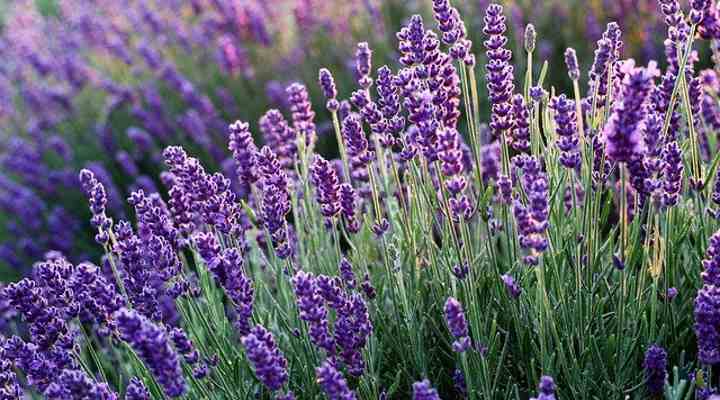
English lavender is a popular front yard shrub known for its fragrant purple blooms and gray-green leaves. This aromatic plant grows in small clumps. It’s characterized by upward-pointing flowering spikes that last the entire summer. English lavender grows 2 to 3 feet (0.6 – 1 m).
When it comes to low-growing shrubs for the front of the house, English lavender is a great addition due to its beautiful flowers. Its low-growing habit and dense foliage act as a natural border to divide areas. Lavender shrubs are also popular in front yards as perennial borders, low hedges, and containers.
The flowers can also be dried and used in potpourri or for culinary purposes.
- USDA Zone: 5 to 9
- Sun Exposure: Full sun
- Soil Type: Light, sandy soil that is well-draining and relatively dry
Dwarf Hinoki Cypress (Chamaecyparis obtusa ‘Nana Gracilis’)
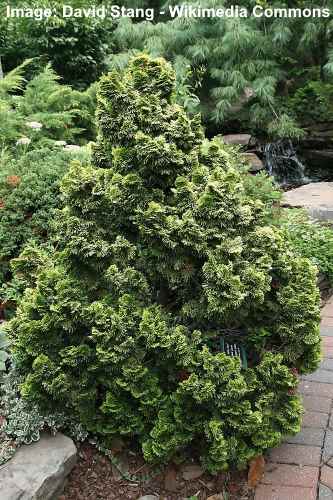
Dwarf Hinoki cypress ‘Nana Gracilis’ is a popular low-growing conifer known for its compact size and lush, dark green foliage. The ‘Nana’ cypress cultivar has a globe-like growth habit that becomes pyramidal as it matures. Female shrubs also develop reddish-brown cones. This small evergreen shrub grows 3 to 6 feet (1 – 1.8 m) tall.
Dwarf Hinoki cypress shrub, with its delicate, feathery texture and attractive shape, adds a touch of elegance to any front garden landscape. The low-maintenance shrub requires minimal pruning or shaping, and its foliage is deer-resistant.
In front yard landscaping, the dwarf Hinoki cypress is a popular plant for a border, hedge, or planting along a fence line. Its compact size makes it suitable for smaller gardens or spaces. This versatile and attractive shrub boosts curb appeal and improves a property’s appearance.
- USDA Zone: 4 to 8
- Sun Exposure: Full sun to partial shade
- Soil Type: Average, moist, well-drained soil that is slightly acidic
Dwarf Butterfly Bush (Buddleja)
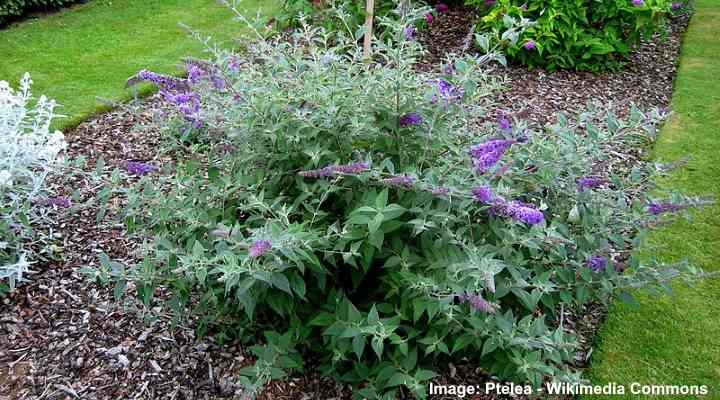
‘Blue Chip’ butterfly bush (Buddleja ‘Blue Chip’)
Dwarf butterfly bush cultivars don’t grow more than three feet (1 m), making them ideal compact shrubs for planting at the front of your house. The compact flowering shrub is known for its attractive conical clusters of fragrant flowers that attract butterflies. The low-growing shrubs bloom with long flower spikes in various colors, including purple, pink, white, and blue.
Dwarf butterfly bushes are drought-tolerant and thrive in full sun and well-drained soil. These shrubs are often used in borders, rock gardens, and containers to add color and fragrance to the landscape. Also, their attractive arching stems have visual appeal in front yards.
- USDA Zone: 5 to 9
- Sun Exposure: Full sun
- Soil Type: Medium moisture soils that are well draining
Dwarf Indian Hawthorn (Rhaphiolepis indica ‘Ballerina’)
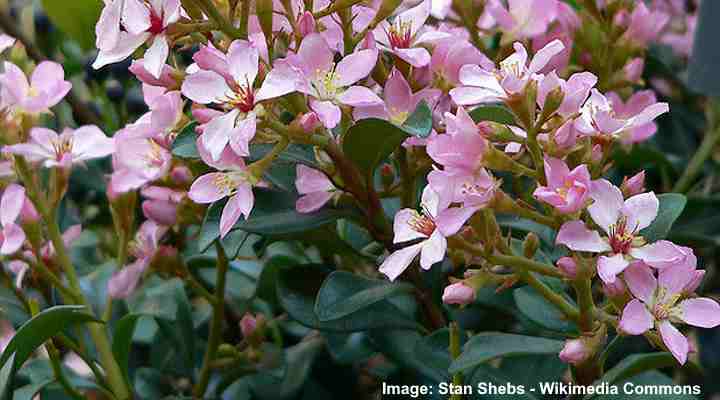
Dwarf Indian hawthorn is a popular evergreen shrub for foundation planting to boost curb appeal. The attractive low-growing shrub has masses of fragrant, pink flowers in loose clusters that burst into color in spring. These crabapple-like blossoms contrast beautifully with thick, leathery, oblong leaves. This compact plant grows to a height of about 2 to 3 feet (60-90 cm) and is commonly used as a ground cover or border plant.
Dwarf Indian hawthorn is an easy-care landscaping shrub for front or backyards. It’s tolerant of drought and poor soil conditions. Typical landscaping uses in front-yard landscaping include shrub borders, planting along a foundation line, and an evergreen flowering hedge. It’s also useful for coastal landscapes and seaside yards as it is highly tolerant to salt spray.
- USDA Zone: 8 to 11
- Sun Exposure: Full sun
- Soil Type: Well-drained, moist soils
Shrub Roses (Rosa)
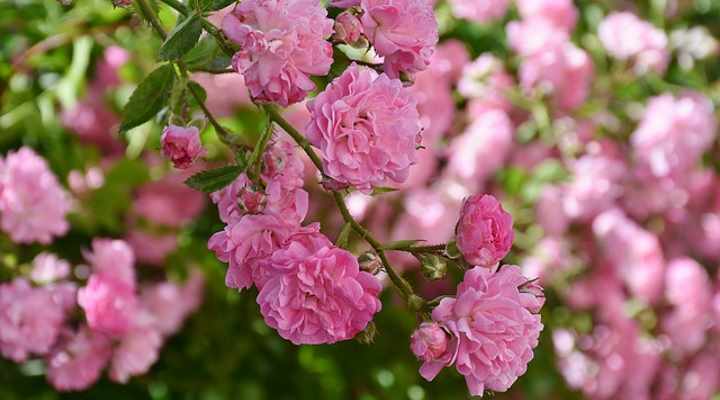
Shrub roses are popular shrubby plants to grow in front yards. The hardy perennial shrubs have spectacular single and double blooms that emerge in late spring and continue reblooming to fall. Shrub roses come in a variety of colors to suit any landscaping options, such as red, pink, apricot, yellow, white, and multicolored blooms.
Thriving in full sun, typically, shrub roses grow 2 to 4 ft. (0.6 – 1.2 m) tall. Characteristics of shrub roses are ruffled double flowers, thorny stems, long-blooming period, and small oval leaves with serrated margins.
Shrub roses are low-maintenance plants with a high tolerance to drought. It’s recommended to prune them in late winter or early spring to maintain shape and encourage abundant blossoms.
- USDA Zone: 4 to 11 (depending on the cultivar)
- Sun Exposure: Full sun
- Soil Type: Rich, fertile soil with excellent drainage
Dwarf Chenille (Acalypha Reptans)

Dwarf chenille is a low-growing evergreen shrub with stunning vibrant crimson flower spikes. Growing less than two feet (60 cm), the free-flowering blossoms appear throughout the year in warm climates. Dwarf chenille spreads out, creating a dense ground cover. The ground-hugging plant creates a mat of lush foliage and fuzzy red flowers.
You can transform your front yard’s landscape into a vibrant space with the effect of dwarf chenille’s distinctive red bottlebrush-like flowers. Thriving in full sun or partial shade, the dwarf shrub is a great choice for red-flowering ground cover in tropical regions or hanging baskets in temperate zones.
- USDA Zone: 9 to 11
- Sun Exposure: Full sun to partial shade
- Soil Type: Well-drained, humus-rich, moist soil
Dwarf Crape Myrtle (Lagerstroemia indica)
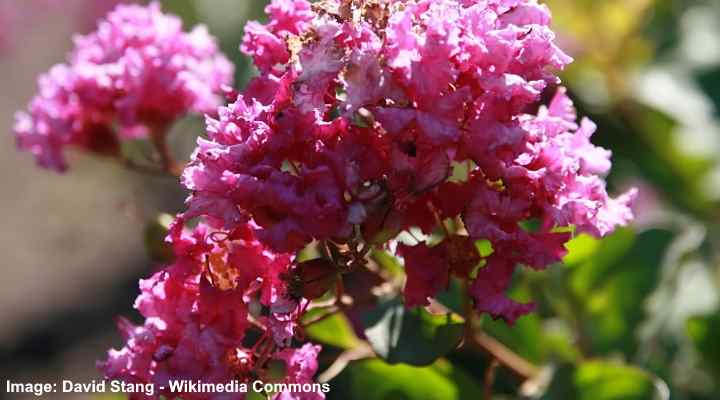
Petite Plum crape myrtle (Lagerstroemia indica ‘Monum’)
Dwarf crape myrtles are compact flowering shrubs for foundation plantings that add a burst of color to your garden landscape. They have a dense, spreading habit with thin, peeling bark and clusters of summer-blooming flowers. Their lush foliage turns orange, red, or yellow in the fall.
Low-growing crape myrtle shrubs grow 3 to 5 ft. (0.9 – 1.5 m) tall. Their endearing quality is the clusters of papery flowers in shades of pink, red, white, and purple. Blooming from summer to fall, dwarf crape myrtle shrubs are ideal for adding color and fragrance to enhance a foundation line, cover a fence, and create a privacy hedge. Additionally, these stunning shrubs perform well in containers to add beauty and charm to any landscape.
- USDA Zone: 7 to 9
- Sun Exposure: Full sunlight for at least six hours daily
- Soil Type: Well-drained clay, loam, or sandy soil
Garland Flower (Daphne cneorum)
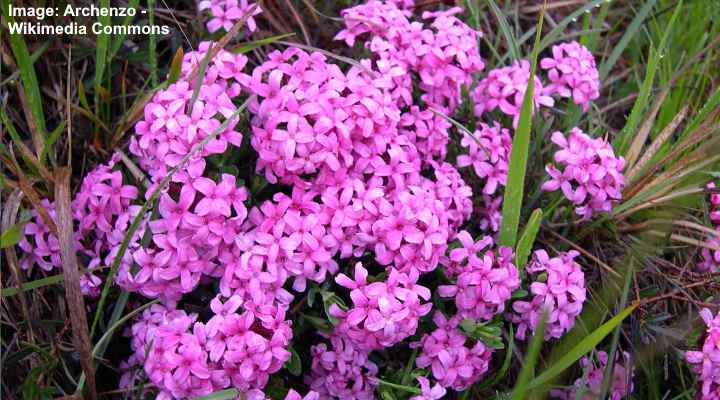
Garland flowers create a beautiful mat of star-shaped purple-pink flowers and lush evergreen foliage in front of your home. Fragrant blooms burst into color in spring and continue blooming sporadically throughout the summer. The flowers are small and clustered, creating a beautiful garland-like effect growing close to the ground.
Garland flowers don’t grow taller than one foot (30 cm) and spread up to 3 ft. (1 m). The spreading, carpet-forming shrub is ideal for pink-flowering ground cover, beds and borders or to line a driveway. Additionally, the ornamental shrub is a lovely addition to the front of a border.
- USDA Zone: 5 to 8
- Sun Exposure: Full sun to partial shade and dappled sunlight
- Soil Type: Neutral to alkaline, well-drained soils
Lydian Broom (Genista lydia)
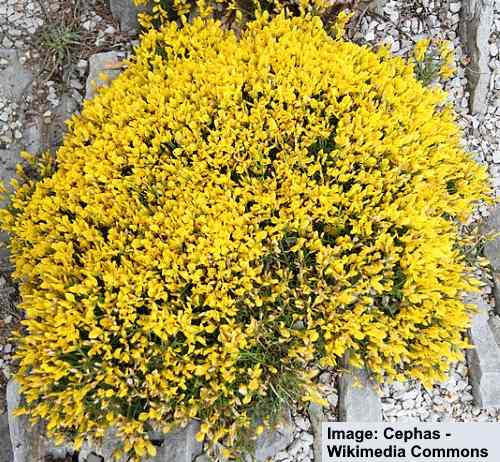
Lydian broom is a compact, low-growing shrub covered in bright yellow flowers in late spring and early summer. This slow-growing ornamental shrub brightens front yards with its profusion of golden flowers blooming on arching or trailing stems. Lydian broom shrubs don’t grow taller than two feet tall (0.6 m).
The small Lydian broom shrub thrives in full sun, and it is one of the easiest yellow-flowering landscaping shrubs to care for. The gorgeous shrubs transform front yards with yellow flowers along a foundation line, full-sun ground cover, or trailing stems cascading over containers. It’s an ideal shrub for xeriscaping front yards.
- USDA Zone: 4 to 9
- Sun Exposure: Full sun
- Soil Type: Poor, infertile, well-drained soils
Rockrose (Cistus spp.)

Rockrose is a group of small flowering evergreen shrubs that work well in front-of-the-house landscaping. The low-growing shrubs produce beautiful five-petaled star-shaped blooms in white or pink shades. Thriving in full sun, these shrubs have a compact, rounded shape with foliage consisting of small, waxy dark green leaves, giving the shrubs a unique appearance.
Thriving in full sun, rockrose shrubs grow 2 to 3 ft. (0.6 – 1 m) tall. Rockrose is a favorite in the category of low-growing shrubs for the front of the house because of its tolerance to heat, drought, salt, and wind. You can plant rockrose shrubs in cottage or city gardens, foundation plantings, or as ground cover.
- USDA Zone: 8 to 11
- Sun Exposure: Full sun
- Soil Type: Well-drained soil
Shrubby Bindweed (Convolvulus cneorum)

Shrubby bindweed is a small evergreen shrub with silver-gray foliage and delicate trumpet-shaped white flowers. This low-growing shrub is ideal for planting at the front of the house because it blooms from late spring through summer. Its mounding, spreading growth habit makes it highly versatile for yard landscaping.
Shrubby bindweed doesn’t grow taller than two feet (60 cm). It’s heat and drought-tolerant and can thrive in dry soils. Its silvery leaves and brilliant white flowers give the shrub an inviting appearance in front yards. Bindweed performs well as a foundation planting, border plant, ground cover, or container plant to add color and texture.
- USDA Zone: 8 to 11
- Sun Exposure: Full sun
- Soil Type: Moderately fertile soil with excellent drainage
Creeping Mahonia (Mahonia repens)

Creeping mahonia is a low-growing evergreen shrub with multi-seasonal interest for front yards. The ornamental features of this mat-forming shrub are its stunning yellow flowers, compact growth, bluish-purple berries, and holly-like glossy leaves. The tough ground-hugging shrub grows no taller than three feet (1 m).
Creeping mahonia is an ideal small shrub for a property’s sunny and partially shaded front areas. This yellow-flowering ground cover plant performs well in borders, rock gardens, and underplanting shrubs. Additionally, it’s a good landscaping option for erosion control and for growing on banks and slopes.
Creeping mahonia is a great choice for adding color and texture to your garden, and it is also attractive to bees and butterflies.
- USDA Zone: 5 to 8
- Sun Exposure: Full sun to partial shade
- Soil Type: Average moisture, well-drained humus-rich soil
Dwarf Mock Orange (Philadelphus ‘Snow Dwarf’)

The dwarf mock orange cultivar ‘Snow Dwarf’ is a compact, low-growing shrub with abundant beautiful white flowers in spring. The multi-stemmed shrub features an arching habit, four-petaled double, white blooms, and oval, dark green leaves. Ideal for planting in tight spaces, this dwarf shrub grows 2 to 3 ft. (0.6 – 1 m) tall and wide.
The name dwarf mock orange comes from the beautiful, fragrant white flowers resembling orange blossoms. The white-flowering shrub performs well when planted along a foundation line, fence, or shrub border. It’s also suitable for creating a low screen or to divide areas of a yard.
- USDA Zone: 4 to 8
- Sun Exposure: Full sun to partial shade
- Soil Type: Most soil types that have excellent drainage
Dwarf Chaste Tree (Vitex agnus-castus)

Dwarf chaste tree is a compact shade-tolerant shrub that produces beautiful, rounded clusters of lavender flowers. This hardy perennial blooms throughout the summer, attracting butterflies and bees to front yards. Its compact nature and low growth habit make it ideal for planting along a property line.
Dwarf chaste tree is a low-maintenance plant that typically grows 3 to 6 ft. (1 – 1.8 m) tall, with many cultivars of various sizes. It’s a drought-tolerant shrub and can withstand hot summer temperatures. This versatile shrub is ideal for perennial borders, flower beds, or as a low hedge in a curb area.
Due to its drought tolerance, dwarf chaste tree shrubs are ideal for xeriscaping and planting in rock gardens. Chaste trees grow as perennial shrubs in the north, meaning they die back in winter. However, in warmer regions, the attractive shrub thrives throughout the year as a small shrub.
- USDA Zone: 5 to 9
- Sun Exposure: Full sun to partial shade
- Soil Type: Well-draining acidic to neutral soils
Rock Cotoneaster (Cotoneaster horizontalis)

Rock cotoneaster is a low-growing, spreading shrub known for its vibrant red berries and attractive foliage. This deciduous shrub features woody stems growing in a herringbone pattern, white, five-petaled flowers in spring, and vibrant scarlet berries in late summer. Ideal for front-of-house ground cover, rock cotoneaster grows 2 to 3 feet (0.6 – 0.9 m) tall and spreads up to 8 feet (2.4 m) wide.
Rock cotoneaster has four-season interest thanks to its spring flowers, lush foliage, and red berries that persist through winter. Besides being an excellent ground cover shrub, cotoneaster performs well as front yard hedging, screening, and cascading over walls or fences.
The drought-tolerant shrub thrives in a wide range of soil conditions. Rock cotoneaster is great for adding color and texture to any front garden or landscape.
- USDA Zone: 5 to 7
- Sun Exposure: Full sun to partial shade
- Soil Type: Dry to medium moisture soils with excellent drainage
Dwarf Japanese Black Pine (Pinus thunbergii ‘Kotobuki’)
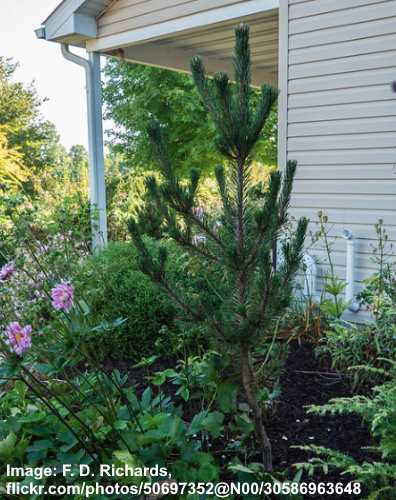
The dwarf Japanese black pine cultivar ‘Kotobuki’ is a stunning evergreen shrub for a front yard. The elegant, compact, slow-growing shrub features dense, dark green needles, creating a unique texture and contrast in the front-of-the-house landscaping. The coniferous shrub’s twisted and contorted branches add to its visual interest.
Growing up to 4 ft. (1.2 m) tall and wide, the dwarf Japanese black pine has an irregular columnar growth. It grows around 6” (15 cm) per year, taking about ten years to reach its mature size. The bright green needles grow in bundles of two.
You can plant the sun-loving evergreen shrub as a focal point or in groups for a dramatic effect. This small shrubby conifer is low-maintenance and can tolerate various soil conditions.
- USDA Zone: 5 to 9
- Sun Exposure: Full sun
- Soil Type: Well-drained soil
Chinese Privet (Ligustrum sinense ‘Sunshine’)
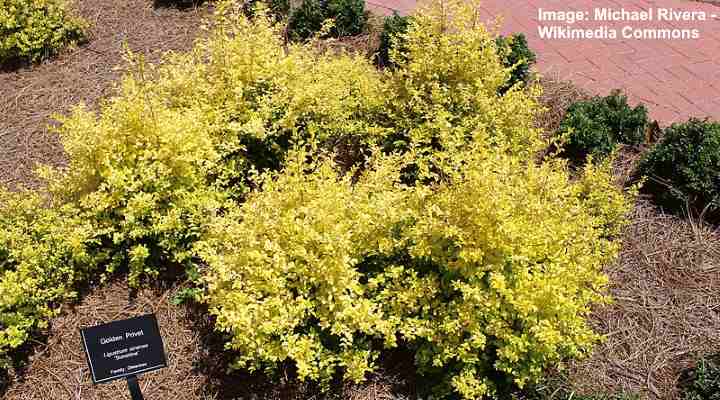
The Chinese privet cultivar ‘Sunshine’ is a compact, evergreen shrub that adds a pop of golden yellow color to front yards. This small shrub is known for its vibrant golden-yellow foliage, white flowers blooming in the summer, and shiny blue-black berries. Its bright yellow ovate leaves grow densely on the small bush.
The Chinese privet ‘Sunshine’ grows 3 to 6 ft. (0.9 – 1.8 m) tall and up to 4 ft. (1.2 m) wide, making it perfect for landscaping a front garden. The low-maintenance shrub performs well as a border plant, foundation planting, hedge, or to create a focal point in the landscape.
The ‘Sunshine’ privet shrub thrives in full sun to partial shade and tolerates salt spray, heat, and drought. The ornamental shrub naturalizes easily in sunny yards. It spreads by self-seeding and underground roots. Therefore, it grows easily along a foundation line without much work. You can also plant it in containers to brighten a front entranceway.
- USDA Zone: 7 to 10
- Sun Exposure: Full sun to partial shade
- Soil Type: Well-drained soil
Oriental Paperbush (Edgeworthia chrysantha)
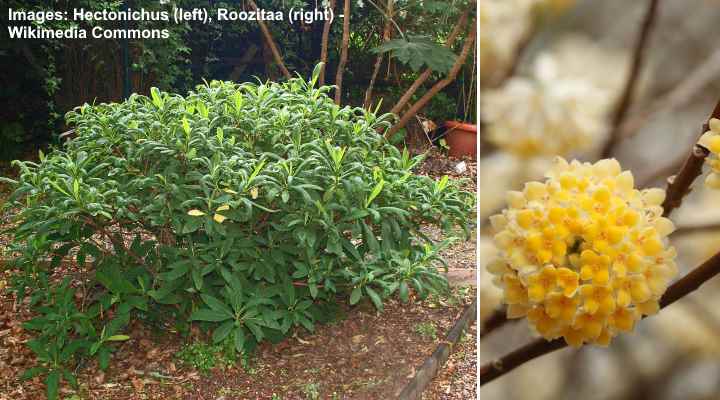
The Oriental paperbush is an eye-catching shrub that blooms in early spring with silky yellow and white flowers on bare branches. The small flowers form rounded clusters 2” (5 cm) across and bloom for up to six weeks. The bushy shrub has narrowly oval, blueish-green leaves 6” (15 cm) long.
The Oriental paperbush’s deciduous foliage drops in the fall, revealing a beautifully structured shrub. It grows 4 to 6 ft. (1.2 – 1.8 m) tall and wide. The easy-care shrub adds a touch of elegance to front yard landscapes. It is attractive in winter when silver buds develop, and the silvery undersides of leaves shimmer in spring and summer breezes.
The Oriental Paperbush thrives in dappled sunlight or shade to full sun. It grows well in shrub borders, foundation plantings, or as a specimen plant.
- USDA Zone: 7 to 10
- Sun Exposure: Full sun, dappled sunlight or partial shade
- Soil Type: Moist, well-drained, humus-rich soils
Winter Daphne ‘Aureomarginata’ (Daphne odora ‘Aureomarginata’)

Winter daphne ‘Aureomarginata’ is a compact evergreen shrub with fragrant purple-pink showy flowers blooming in mid-spring. The compact ornamental shrub has dark green, variegated leaves 4” (10 cm long), perfect for front yard landscaping. Its attractive flowers fill spring landscapes with a sweet and intoxicating fragrance.
The ‘Aureomarginata’ winter daphne grows 3 to 4 feet (0.9 – 1.2 m) tall and wide. This versatile shrub is perfect for growing in shrub borders, foundation plantings, an evergreen hedge, or flowering privacy screen. Additionally, winter daphne grows well in containers to add year-long color and texture to patios or front doorways.
Thriving in partial shade, the small shrub is deer-tolerant and easy to care for.
- USDA Zone: 7 to 9
- Sun Exposure: Partial shade or dappled sunlight
- Soil Type: Well-drained, fertile soil that holds moisture
Littleleaf Boxwood ‘Compacta’ (Buxus microphylla ‘Compacta’)
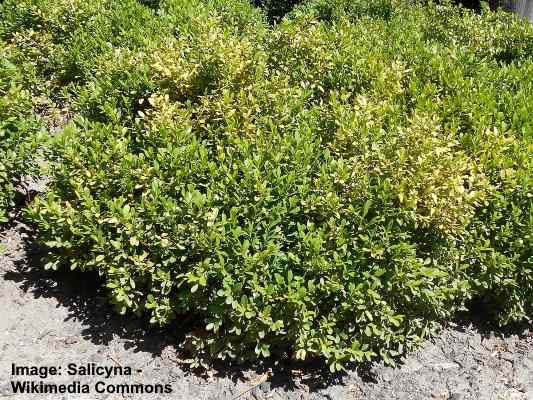
Littleleaf boxwood ‘Compacta’ is a small, dense, evergreen perennial shrub with small oval leaves growing on the rounded plant. This compact boxwood cultivar stays green year-round, providing a vibrant backdrop for other plants in a front yard. The shrub grows up to 4 ft. (1.2 m) and has a rounded, compact shape.
Littleleaf boxwood ‘Compacta’ is a versatile shrub with several uses when landscaping a front yard. You can plant it as a low hedge, pathway edging, foundation planting, or a natural barrier. It’s also a great evergreen shrub for growing in containers to add greenery and structure to the front porch or patio.
This boxwood cultivar is easy to care for and is resistant to deer and rabbits.
- USDA Zone: 6 to 9
- Sun Exposure: Full sun, dappled sunlight, or partial shade
- Soil Type: Well-drained soil high in organic matter
Boxwood ‘Silver Beauty’ (Buxus sempervirens ‘Silver Beauty’)
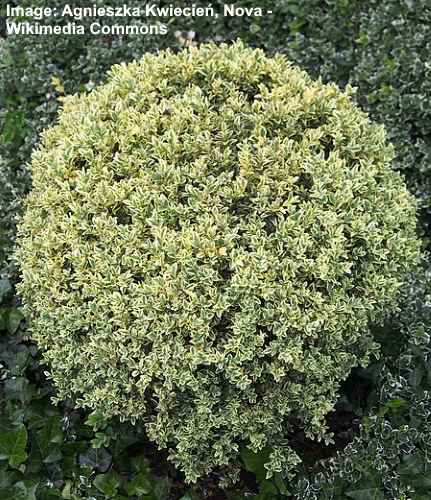
The boxwood cultivar’ Silver Beauty’ is ideal for planting at the front of the house because it only grows 3 feet (0.9 m) tall. The compact evergreen shrub has oblong variegated leaves. They are dark green with creamy-white irregular margins. The elegant landscaping shrub has a dense, pyramidal to rounded habit, ideal for growing in small landscapes.
Boxwood’ Silver Beauty’ cultivar is popular in front-yard landscaping projects. You can plant it in groupings to create borders, hedges, or barriers. It also works well in foundation plantings or shrub borders in front yards. Its compact size makes it suitable for growing in containers or as a topiary plant.
- USDA Zone: 5 to 8
- Sun Exposure: Full sun to partial shade
- Soil Type: Well-drained, fertile soil
Inkberry ‘Shamrock’ (Ilex glabra ‘Shamrock’)
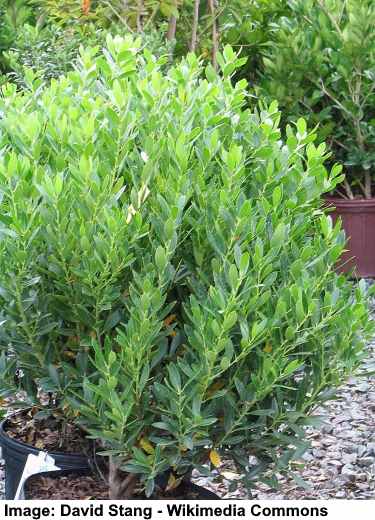
The inkberry’ Shamrock’ is a compact evergreen shrub with spineless, glossy green leaves, small greenish-white flowers, and blue-black berries. Growing 3 to 4 ft. (0.9 – 1.2 m) tall, this dwarf shrub doesn’t take up much room. The shrub adds visual interest to winter landscaping thanks to its year-long green foliage and long-lasting berries.
Dwarf inkberry shrubs are ideal for planting in well-drained soils in part shade or direct sunlight. Their tolerance for wet soils makes the shrubs ideal for landscaping front yards with poor drainage. It performs well as an evergreen hedge, foundation planting, or shrub border. Also, it is drought and salt-tolerant, making it suitable for coastal landscapes.
- USDA Zone: 4 to 9
- Sun Exposure: Full sun to part shade
- Soil Type: Wet or dry soil and neutral to acidic, well-drained soils
Forsythia ‘Happy Centennial’

Forsythia ‘Happy Centennial’ is a dwarf shrub for front yards growing less than 3 feet (0.9 m) tall. Its bright yellow spring flowers add a burst of color to the front-of-house area. The four-petalled yellow flowers contrast with the leathery, dark green leaves. This shrub is one of the hardiest yellow forsythia shrubs.
The ‘Happy Centennial’ grows 2 to 3 feet (0.6 – 0.9 m) and 3 to 5 ft. (0.9 – 1.5 m) wide. The graceful shrub has low horizontal branching, adding to its ornamental appeal. The abundant yellow flowers in spring brighten foundation lines, hedges, or mixed borders. It’s a trouble-free shrub resistant to deer and rabbits.
- USDA Zone: 5 to 9
- Sun Exposure: Full sun to partial shade
- Soil Type: Well-drained soil with medium moisture
Korean Forsythia (Forsythia ovata)

The Korean forsythia is one of the first yellow-flowering shrubs to bloom in spring. Small, pale yellow flowers bloom on bare branches in late winter. In late spring, dark green, ovate leaves appear and densely cover the arching branches. Drought-tolerant and suitable for partial shade, the Korean forsythia is ideal for front yards.
The Korean forsythia grows 4 to 5 ft. (1.2 – 1.5 m) tall and up to 7 ft. (2.1 m) wide. Best flowering occurs when planted in full sun and medium moisture soils.
The versatile shrub enhances curb appeal in several ways. Its pale yellow flowers look stunning growing along the house’s front, in mixed borders, or as a flowering hedge. With its arching branches and vibrant flowers, this shrub will catch the eye of anyone passing by.
- USDA Zone: 5 to 7
- Sun Exposure: Full sun to partial shade
- Soil Type: Well-drained, medium moisture soil
Dwarf Viburnum
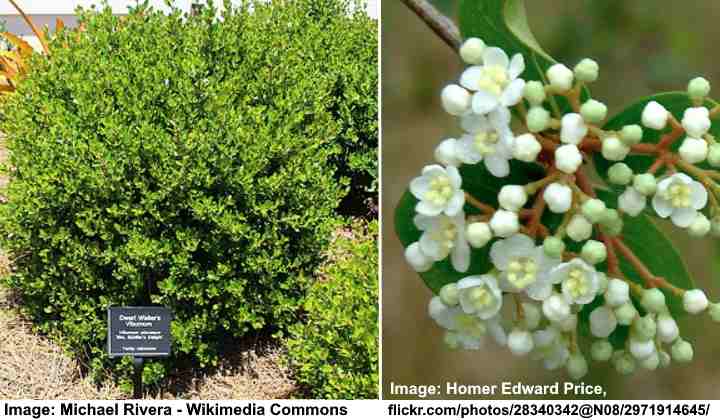
Dwarf Walter’s Viburnum obovatum (in the picture) is a perfect shrub for small, compact front gardens. It grows between 1 and 5 ft. (0.3 – 1.5 m) tall
Dwarf viburnum shrubs can boost the curb appeal of your front yard with their bushy growth, masses of white spring flowers, and evergreen foliage. Viburnum shrubs for front-of-house landscaping grow up to 4 ft. (1.2 m) tall. The compact shrubs are versatile additions to front gardens.
Here are three popular dwarf viburnum shrubs for planting in a front yard:
Viburnum obovatum ‘Raulston Hardy’: This low-growing, evergreen shrub blooms in spring with clusters of small white flowers followed by bright red or black berries in fall. It grows 3 to 4 ft. (0.9 – 1.2 m) tall and wide.
Viburnum dentatum ‘Papoose’: This small shrub is ideal for the front of the house, thanks to its compact growth habit. The white-flowering shrub grows 3 to 4 ft. (0.9 – 1.2 m) tall and wide.
Viburnum dentatum ‘Blue Muffin’: This small viburnum cultivar blooms in spring with clusters of white flowers, followed by blue fruits in the fall. It grows around 5 ft. (1.5 m) tall and wide.
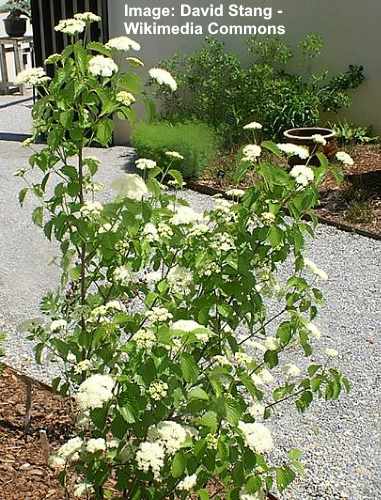
Viburnum dentatum ‘Blue Muffin’
- USDA Zone: 3 to 8, depending on the specific variety
- Sun Exposure: Full sun to partial shade
- Soil Type: Easy to grow in well-drained, medium moisture soils and is drought-tolerant when established
Korean Barberry (Berberis koreana)
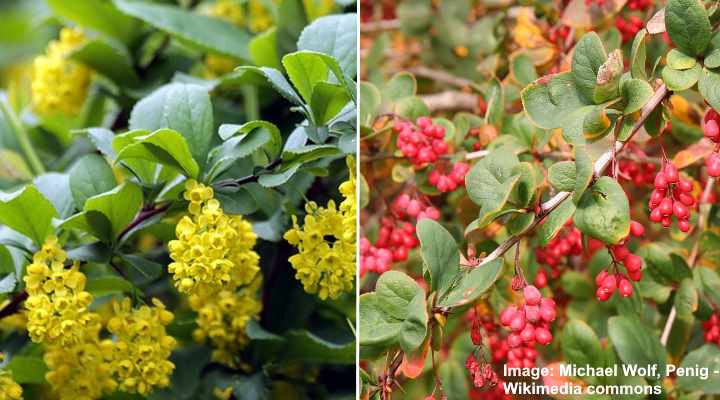
The Korean barberry is a low-growing, deciduous or semi-evergreen shrub that blooms in spring with clusters of small golden-yellow flowers. The multi-stemmed shrub is a great addition to front landscapes. The bushy plant has compact growth, medium green leaves with deep purple or maroon fall colors, and bright red, egg-shaped berries.
Korean barberry shrubs are exceedingly cold-hardy. The semi-evergreen shrub features a dense, rounded habit. Uses in a front yard include foundation planting, informal hedge, windbreak, or privacy screen. Its tolerance to drought, deer, and poor soils makes it highly versatile in most landscapes.
Whether used as a border, focal point, or mass planting, this shrub will enhance curb appeal and create a welcoming entrance to your home.
- USDA Zone: 3 to 7
- Sun Exposure: Full sun to partial shade
- Soil Type: Dry to moist soils that have excellent drainage
Japanese Barberry ‘Atropurpurea Nana’ (Berberis thunbergii ‘Atropurpurea Nana’)

The Japanese Barberry ‘Atropurpurea Nana’ is a stunning dwarf shrub with vibrant purple or bright red foliage. The colorful ornamental shrub has small, ovate reddish-purple leaves, fragrant, pale yellow flowers, and bright red berries. The front-of-house shrub doesn’t grow taller than 2 feet (0.6 m) and spreads up to 3 ft. (0.9 m).
This compact shrub’s deep red foliage adds interest to landscapes in the front of buildings. The bushy plant is perfect for planting along foundation lines or pathways. Additionally, the pest-free shrub grows well as a small hedge, barrier, or single specimen plant.
- USDA Zone: 4 to 8
- Sun Exposure: Full sun to partial shade
- Soil Type: Well-drained, dry to medium soil, and it tolerates most soil types
Minuet Weigela (Weigela florida ‘Minuet’)

The Weigela ‘Minuet’ is a dwarf flowering shrub with purplish-red funnel-shaped blooms and green leaves with a purplish tinge. This front-yard shrub blooms profusely in spring with fragrant flowers and reblooms in mid to late summer. Its green purplish leaves retain their color throughout the season before dropping in the fall.
The low-growing Weigela’ Minuet’ cultivar enhances front yard aesthetics with its beauty and charm. Its showy flowers add color and fragrance to shrub borders, foundation plantings, and small hedges. It’s ideal for planting at the front of a house as it doesn’t grow taller than 3 feet (0.9 m) and spreads up to 4 feet (1.2 m).
The ‘Minuet’ Weigela is also low-maintenance and easy to care for, making it a great choice for busy homeowners.
- USDA Zone: 4 to 8
- Sun Exposure: Full sun
- Soil Type: Well-drained soils
Dwarf Yaupon Holly (Ilex vomitoria ‘Nana’)

The dwarf yaupon holly is a fast-growing evergreen shrub with small greenish-white flowers, bright green foliage, and red berry-like drupes in the fall and winter. It has thin, grayish-silver bark and stems. This small shrub grows 3 to 5 feet (0.9 – 1.5 m) tall and up to 6 ft. (1.8 m) wide.
This low-growing holly cultivar adds color and texture to front-of-house landscapes. Its shiny green leaves and contrasting red berries look beautiful in winter landscapes. You can plant the versatile landscaping shrub in foundation plantings, as a low hedge, or as an accent plant. Its compact size makes it a great choice for small front gardens or containers.
- USDA Zone: 7 to 9
- Sun Exposure: Full sun to partial shade
- Soil Type: Well-drained soil; however, it can tolerate drought and occasional flooding
Small Shade Tolerant Shrubs for Front of the House (With Pictures)
Many low-growing shrubs thrive in dappled sunlight, partial shade, or deep shade. Here are a few shrubs that don’t grow very tall and are ideal for creating a vibrant landscape in your front yard.
Wintergreen Barberry (Berberis julianae)

Wintergreen barberry is a versatile cold-hardy evergreen shrub to add visual interest to your front yard throughout the year. This shade-tolerant flowering shrub features clusters of golden yellow flowers, glossy, dark green leaves, and vibrant waxy bluish berries that persist through fall. Wintergreen barberry grows up to 4 to 6 feet (1.2 – 1.8 m) tall.
In addition to its attractive flowers, foliage, and berries, wintergreen barberry has spiny branches. These thorn-covered stems make the evergreen shrub ideal for a security barrier under a window or along a front fence. Other landscaping uses for this thorny shrub are a privacy hedge, screen, or natural barrier.
Apart from improving your front yard aesthetics, wintergreen barberry flowers also attract pollinators such as bees and butterflies, adding even more life to your garden.
- USDA Zone: 6 to 8
- Sun Exposure: Full sun to partial shade
- Soil Type: Well-drained soil
Minuet Mountain Laurel (Kalmia latifolia ‘Minuet’)
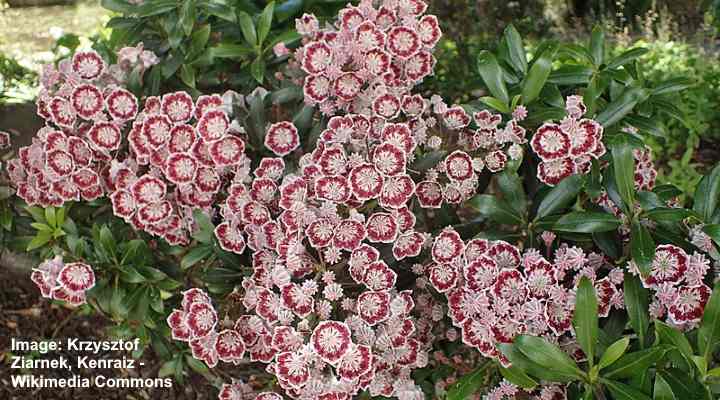
Minuet mountain laurel is a compact evergreen shrub that produces beautiful clusters of pink and white flowers in late spring to early summer. This variety of mountain laurel is known for its smaller size, growing up to 3 to 4 feet (0.9 – 1.2 m) tall and wide. The dark green foliage adds year-round interest to the garden.
Minuet mountain laurel is a low-maintenance front of house shrub that thrives in partial shade to full sun. It prefers well-drained, acidic soil and is tolerant of drought once established. This shrub is ideal for woodland gardens and borders and as a focal point in the landscape. It also attracts butterflies and hummingbirds.
- USDA Zone: 5 to 9
- Sun Exposure: Partial shade to full sun
- Soil Type: Well-drained, acidic soil
Dwarf English Boxwood (Buxus sempervirens ‘Suffruticosa’)
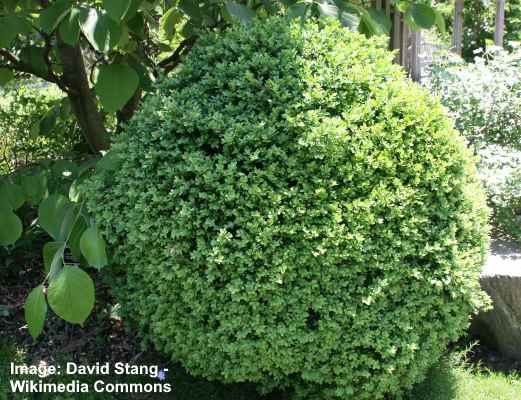
Dwarf boxwood shrubs stay low and well-groomed, providing a neat appearance for your front yard.
Dwarf English boxwood is a compact evergreen shrub commonly used for hedging and borders. It has small, glossy, dark green leaves with an oval shape. This slow-growing shrub grows up to 2 to 4 feet (0.6 – 1.2 m) tall and wide.
Dwarf English boxwood is easy to grow and maintain. It tolerates a wide range of soil conditions and is drought-tolerant once established. It prefers full sun to partial shade and is deer-resistant. This versatile shrub can be used in formal gardens, as foundation plantings, or as a low hedge. It can also be shaped and pruned into topiaries or other decorative forms.
- USDA Zone: 5 to 8
- Sun Exposure: Full sun to partial shade
- Soil Type: Well-drained soil
Virginia Sweetspire (Itea virginica)
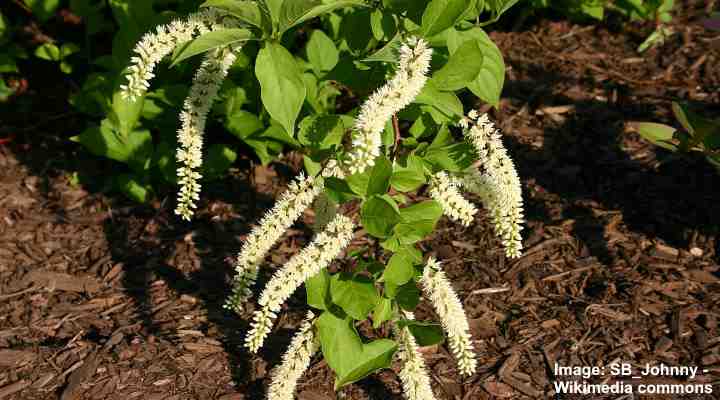
Virginia sweetspire is a deciduous shrub native to the eastern United States with eye-catching cylindrical white flower clusters. The creamy-white flowers bloom in mid-spring to early summer, covering the shrub, making it look white. The front-yard landscaping shrub has attractive dark green foliage that turns vibrant shades of red, orange, and purple in the fall.
Virginia sweetspire grows 3 to 10 ft. (1 – 3 m) tall and wide, making it suitable for small and large front yards. The white-flowering shrub is great for foundation planting, hedgerows, and shrub borders. Additionally, you can plant it near water features due to its tolerance for wet conditions.
- USDA Zone: 5 to 10
- Sun Exposure: Full sun, partial shade, deep shade
- Soil Type: Medium to wet soils that drain well
Dwarf Hydrangea
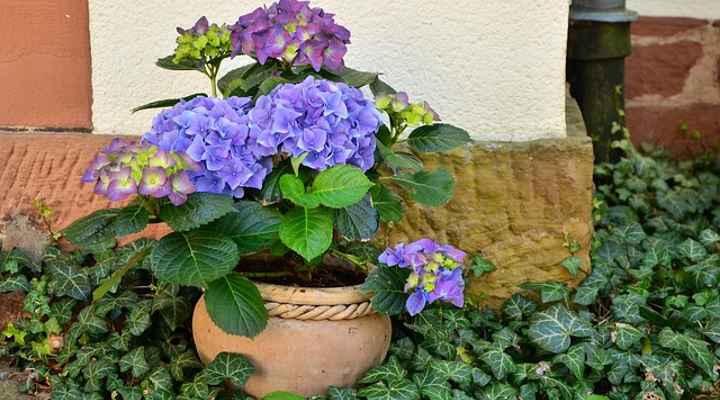
Several varieties of dwarf hydrangeas stay small without pruning. The beautiful shrubs are known for their large, showy flower heads in pink, blue, lilac, purple, and white shades. Hydrangea flowers can be mophead, lacecap, or conical clusters. Most dwarf hydrangeas have pointed, leathery leaves with serrated edges.
Here are four dwarf hydrangeas suitable for planting along a foundation line:
Mophead Hydrangea (Hydrangea macrophylla): This hydrangea variety has large, rounded flower heads and leaves. The blue or pink flowers typically measure 6” to 8” (15 – 20 cm) across. They grow 3 to 4 ft. (0.9 – 1.2 m) tall and wide.

Mophead Hydrangea (Hydrangea macrophylla)
Lacecap Hydrangea (Hydrangea macrophylla normalis): This is an ideal shrub for the front of the house. It has showy lacecap flowers in blue or pink shades, depending on the soil’s pH levels. It grows 3 to 5 ft. (0.9 – 1.5 m) tall and wide.
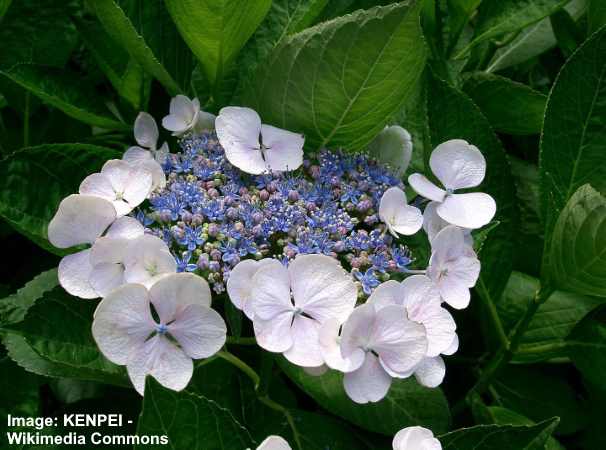
Hydrangea macrophylla normalis
Little Lime Panicle Hydrangea (Hydrangea paniculata ‘Little Lime’): This low-growing shrub with green flowers doesn’t grow taller than 5 ft. (1.5 m). The lime green flowers gradually turn pink throughout the season.
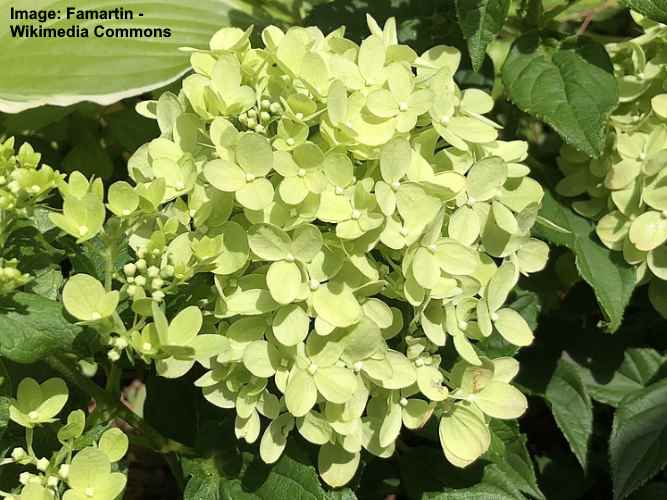
Hydrangea paniculata ‘Little Lime’
Mountain Hydrangea ‘Bluebird’ (Hydrangea serrata ‘Bluebird’): This dwarf cultivar is ideal for planting in a front yard due to its low growth. The small shrub has dark green leaves and pretty lacecap flowers. It thrives in full sun. This hydrangea cultivar grows 3 to 4 ft. (0.9 – 1.2 m) tall and wide.
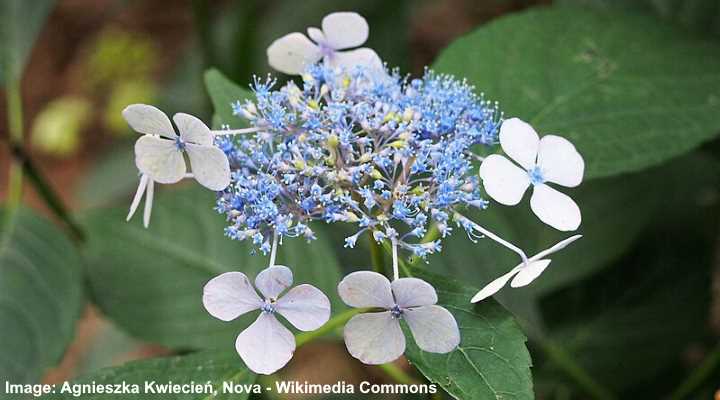
Hydrangea serrata ‘Bluebird’
- USDA Zone: 3 to 8
- Sun Exposure: Full sun, dappled shade, or partial shade
- Soil Type: Well-drained soil
Related articles:
- Best Flowering Plants For Front of House (Shrubs, Annual Flowers, Perennials)
- Small Trees For Front Yard
- Front Yard Evergreen Shrubs
